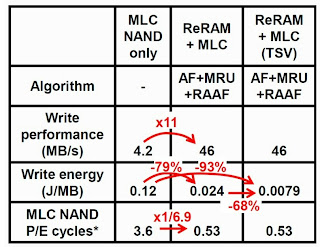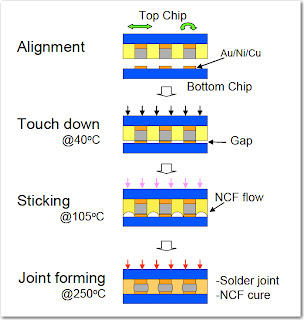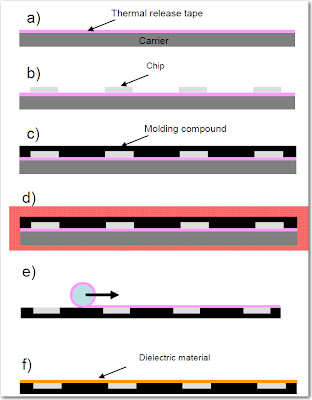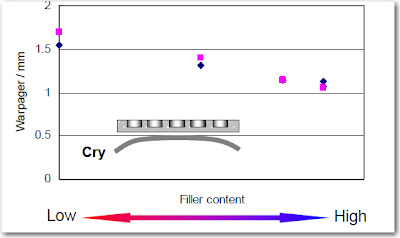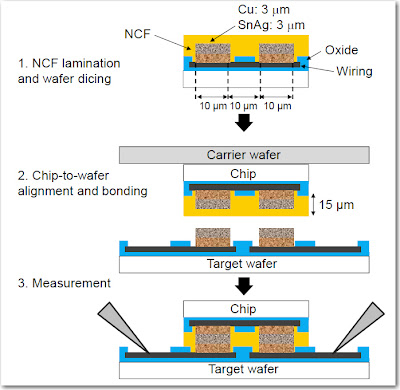The IEEE Symposium on VLSI Technology is sponsored by the Electron Devices Society -- ED and the Solid-State Circuits Society -- SSC. At this year's conference, Micron gave further details on their hybrid memory Cube and TI detailed their studies on TSV induced stress on 28nm CMOS and Chuo Univ described a hybrid NAND + ReRAM SSD stack with better power consumption and product lifetime.
Hybrid SSD memory stack with ReRAM and TSVPerofessor Takeuchi of Chuo Univ described a hybrid SSD architecture using ReRAM and high capacity NAND flash memory.
When SSDs are used for servers in financial institutions, performance is hindered and power consumption increased because random access is dominant. This causes data to get split up if the size of the data packets are not of the appropriate size (minimum for NAND is 16Kb). Takeuchi's memory stack combines a NAND flash memory and ReRAM. ReRAM is used as both cache and storage memories. To overwrite a small amount of data in the NAND flash memory, software transfers the page of data to the ReRAM so that data is not fragmented in the NAND flash memory.
(Click on any of the images below to enlarge.)
A prototype, tested on an emulator, showed that compared with existing SSDs which only use NAND, the hybrid memory stack achieves an 11X higher data writing performance, 93% lower power consumption and 6.9 times longer product life. This assumed that the controller, ReRAM and NAND flash memory were connected by TSV. Although this has been hyped up by several reporters, we should note that it is possible to achieve almost the same results without using TSV. The major gain of using the TSV appears to be a 14% decrease in energy required to write as shown in the comparative table below.
It is proposed that SSD in data centers would have to be changed out about 7 times less thus reducing expenses.
It should be noted that in order to use the hybrid SSD architecture for different applications, it is necessary to change the controlling software algorithms.
Micron Hybrid Memory Cube (HMC)
We have previously discussed the fact that Micron has created an industry group to collaborate on the implementation of an open interface specification for a new memory technology called the Hybrid Memory Cube (HMC). [http://www.hybridmemorycube.org/]The HMC is a stack of multiple thinned memory die sitting atop a logic chip bonded together using TSV. This greatly increases available DRAM bandwidth by leveraging the large number of I/O pins available through TSVs. The HMC requires about 10% of the volume of a DDR3 memory module. It is claimed that the technology provides 15X the performance of a DDR3 module, uses 70% less energy per bit than DDR3 and uses 90% less space than today's RDIMMs. [see IFTLE 95 "3DIC - Time Flies When You're Having Fun; Further Details on theMicron HMC..."; IFTLE 74 "The Micron Memory Cube consortium"]
The HMC device uses TSV technology and fine pitch copper pillar interconnect. The DRAM logic, responsible for DRAM sequencing, refresh, data routing and error correction is placed in a separate high performance logic die. DRAM and logic are connected by thousands of TSV. The DRAM is a slave to the logic layer timing control. The HMC was constructed with 1866 TSVs on a roughly 60um pitch.
HMC electrical performance is are compared to other DRAM modules below.
TI Studies Impact of TSV Stress on Electrical Performance
They found that the impact of TSVs on surrounding Si is tensile but that a tensile etch stop layer (ESL) counters the impact of the TSVs on near-surface Si where devices are present. Also, insertion of compressive shallow trench isolation (STI) between the TSV and device will also act to buffer this impact.
They conclude that "...the electrical properties of N/PFETs between 4 and 16um of TSVs are negligibly impacted (less than 2.3%)..." and that For Wide-IO Memory-Logic interface applications employing a 40 x 50 um JEDEC TSV array, ESD and decoupling capacitors which do not contain N/PFETs can be placed immediately adjacent to TSVs such that CMOS logic circuitry does not require placement less than 4 um.
CFL Fails While Incandescent Lester Still Going Strong
So cousin CFL operated 11 months saving me 1/30 of $4.31 or 14 cents / month or $ 1.54 in 11 months …but remember the bulb cost me $3.97 . You can do the math. And remember since the CFL’s contain mercury, I’m now supposed to contact the EPA for proper disposal instructions (yeah right !)
Cousin CFL and cousin LED promised me "hope and change"... "to transform US power consumption as we know it today." So far, I'm down $2.43 and need to replace the bulb. Typical Govt BS !
I guess we can understand now why the Govt. got involved to ban poor Lester from the shores of the US. Would anyone actually buy these CFL or LED bulbs, unless they were forced to ?
Cousin LED is still burning bright as are all the incandescants that were started at the same time. Be assured we will keep you up to date on cousin LEDs health !
For all the latest on 3DIC and advanced packaging stay linked to IFTLE.............................
TI researchers have used NanoBeam Diffraction (NBD) to measure near-TSV Si strain in fully processed wafers. The electrical behavior of poly-SiON P/NFET transistors were characterized for full thickness wafers varying temperature, orientations and proximities to isolated and arrayed TSVs.
NanoBeam Diffraction measurements of Si strain within 5 um of TSVs were acquired for samples prepared from fully processed wafers, showing that for proximity greater than 1.5 um the impact of TSVs is negligible.

